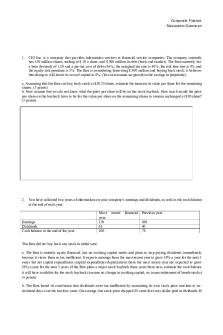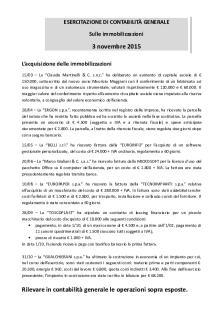Esercitazione 3 PDF

| Title | Esercitazione 3 |
|---|---|
| Course | Programmazione e controllo della produzione |
| Institution | Politecnico di Torino |
| Pages | 4 |
| File Size | 215.4 KB |
| File Type | |
| Total Downloads | 9 |
| Total Views | 148 |
Summary
Esercitazione nº 3 di pcp fatta da Arianna Alfieri...
Description
Q3.1 Consider a process consisting of three resources:
What is the bottleneck? What is the process capacity? What is the flow rate if demand is eight units per hour? What is the utilization of each resource if demand is eight units per hour?
Q3.2 Consider a process consisting of five resources that are operated eight hours per day. The process works on three different products, A, B, and C:
Demand for the three different products is as follows: product A, 40 units per day; product B, 50 units per day; and product C, 60 units per day. What is the bottleneck? What is the flow rate for each flow unit assuming that demand must be served in the mix described above (i.e., for every four units of A, there are five units of B and six units of C)?
Q3.3 International Cranberry Uncooperative (ICU) is a competitor to the National Cranberry Cooperative (NCC). At ICU, barrels of cranberries arrive on trucks at a rate of 150 barrels per hour and are processed continuously at a rate of 100 barrels per hour. Trucks arrive at a uniform rate over eight hours, from 6:00 a.m. until 2:00 p.m. Assume there are sufficiently small so that the delivery of cranberries can be treated as a continuous inflow. The first truck arrives at 6:00 a.m. and unloads immediately, so processing begins at 6:00 a.m. The bins at ICU can hold up to 200 barrels of cranberries before overflowing. If a truck arrives and the bins are full, the truck must wait until there is room in the bins. a. What is the maximum number of barrels of cranberries that are waiting on the trucks at any given time? b. At what time do the trucks stop waiting? c. At what time do the bins become empty? d. ICU is considering using seasonal workers in addition to their regular workforce to help with the processing of cranberries. When the seasonal workers are working, the processing rate increases to 125 barrels per hour. The seasonal workers would start working at 10:00 a.m. and finish working when the trucks stop waiting. At what time would ICU finish processing the cranberries using these seasonal workers?
Q3.6 VF is a small accounting firm supporting wealthy individuals in their preparation of annual income tax statements. Every December, VF sends out a short survey to their customers, asking for the information required for preparing the tax statements. Based on 24 years of experience, VF categorizes their cases into the following groups: • Group 1 (new customers, easy): 15 percent of cases • Group 2 (new customers, complex): 5 percent of cases • Group 3 (repeat customers, easy): 50 percent of cases • Group 4 (repeat customers, complex): 30 percent of cases Here, “easy” versus “complex” refers to the complexity of the customer’s earning situation. In order to prepare the income tax statement, VF needs to complete the following set of activities. Processing times (and even which activities need to be carried out) depend on which group a tax statement falls into. All of the following processing times are expressed in minutes per income tax statement.
The activities are carried out by the following three persons: • Administrative support person: filing and writing. • Senior accountant (who is also the owner): initial meeting, review by senior accountant. • Junior accountant: preparation. Assume that all three persons work eight hours per day and 20 days a month. For the following questions, assume the product mix as described above. Assume that there are 50 income tax statements arriving each month. a. Which of the three persons is the bottleneck? b. What is the (implied) utilization of the senior accountant? The junior accountant? The administrative support person? c. You have been asked to analyze which of the four product groups is the most profitable. Which factors would influence the answer to this? d. How would the process capacity of VF change if a new word processing system would reduce the time to write the income tax statements by 50 percent?
Q3.5 Consider a bagel store selling three types of bagels that are produced according to the process flow diagram outlined below. We assume the demand is 180 bagels a day, of which there are 30 grilled veggie, 110 veggie only, and 40 cream cheese. Assume that the workday is 10 hours long and each resource is staffed with one worker.
Processing times:
Processing times are independent of which bagel type is processed at a resource (for example, cutting a bagel takes the same time for a cream cheese bagel as for a veggie bagel). a. Where in the process is the bottleneck? b. How many units can the process produce within one hour, assuming the product mix has to remain constant?
Q3.9 Kim Opim, an enthusiastic student, is on her flight over from Philadelphia (PHL) to Paris. Kim reflects upon how her educational experiences from her operations courses could help explain the long wait time that she experienced before she could enter the departure area of Terminal A at PHL. As an airline representative explained to Kim, there are four types of travelers in Terminal A: • Experienced short-distance (short-distance international travel destinations are Mexico and various islands in the Atlantic) travelers: These passengers check in online and do not speak with any agent nor do they take any time at the kiosks. • Experienced long-distance travelers: These passengers spend 3 minutes with an agent. • Inexperienced short-distance travelers: These passengers spend 2 minutes at a kiosk; however, they do not require the attention of an agent. • Inexperienced long-distance travelers: These passengers need to talk 5 minutes with an agent. After a passenger checks in online, or talks with an agent, or uses a kiosk, the passenger must pass through security, where they need 0.5 minutes independent of their type. From historical data, the airport is able to estimate the arrival rates of the different customer types at Terminal A of Philadelphia International: • Experienced short-distance travelers: 100 per hour • Experienced long-distance travelers: 80 per hour • Inexperienced short-distance travelers: 80 per hour • Inexperienced long-distance travelers: 40 per hour At this terminal, there are four security check stations, six agents, and three electronic kiosks. Passengers arrive uniformly from 4 p.m. to 8 p.m., with the entire system empty prior to 4 p.m. (the “midafternoon lull”) and no customers arrive after 8 p.m. All workers must stay on duty until the last passenger is entirely through the system (e.g., has passed through security). a. What are the levels of implied utilization at each resource? b. At what time has the last passenger gone through the system? Note: If passengers of one type have to wait for a resource, passengers that do not require service at the resource can pass by the waiting passengers! c. Kim, an experienced long-distance traveler, arrived at 6 p.m. at the airport and attempted to move through the check-in process as quickly as she could. How long did she have to wait before she was checked at security? d. The airline considers showing an educational program that would provide information about the airport’s check-in procedures. Passenger surveys indicate that 80 percent of the inexperienced passengers (short or long distance) would subsequently act as experienced passengers (i.e., the new arrival rates would be 164 experienced short-distance, 112 experienced long-distance, 16 inexperienced short-distance, and 8 inexperienced long-distance [passengers/hour]). At what time has the last passenger gone through the system?...
Similar Free PDFs

Esercitazione 3
- 6 Pages

Esercitazione 3
- 4 Pages

Esercitazione 3 novembre
- 2 Pages

Esercitazione 3.pdf m
- 61 Pages

Esercitazione 3 con sol
- 3 Pages

Esercitazione capitolo 3 mse
- 8 Pages

Esercizi 3 04 2019 - esercitazione
- 20 Pages

3. Esercitazione Valore di realizzo
- 13 Pages

Esercitazione 2
- 10 Pages

Skilla - esercitazione
- 9 Pages

Esercitazione-02
- 8 Pages

Stechiometria - esercitazione
- 54 Pages

Esercitazione 2
- 15 Pages

Esercitazione pec
- 1 Pages

Esercitazione laboratorio gioco
- 3 Pages
Popular Institutions
- Tinajero National High School - Annex
- Politeknik Caltex Riau
- Yokohama City University
- SGT University
- University of Al-Qadisiyah
- Divine Word College of Vigan
- Techniek College Rotterdam
- Universidade de Santiago
- Universiti Teknologi MARA Cawangan Johor Kampus Pasir Gudang
- Poltekkes Kemenkes Yogyakarta
- Baguio City National High School
- Colegio san marcos
- preparatoria uno
- Centro de Bachillerato Tecnológico Industrial y de Servicios No. 107
- Dalian Maritime University
- Quang Trung Secondary School
- Colegio Tecnológico en Informática
- Corporación Regional de Educación Superior
- Grupo CEDVA
- Dar Al Uloom University
- Centro de Estudios Preuniversitarios de la Universidad Nacional de Ingeniería
- 上智大学
- Aakash International School, Nuna Majara
- San Felipe Neri Catholic School
- Kang Chiao International School - New Taipei City
- Misamis Occidental National High School
- Institución Educativa Escuela Normal Juan Ladrilleros
- Kolehiyo ng Pantukan
- Batanes State College
- Instituto Continental
- Sekolah Menengah Kejuruan Kesehatan Kaltara (Tarakan)
- Colegio de La Inmaculada Concepcion - Cebu
